Reborn Hybrid, All-Wheel-Drive Family Hauler
The Toyota Venza is an all-new vehicle with an “old” name. In the super competitive “utility” field, it’s an effective people mover with style that features a hybrid powertrain and all-wheel drive on all three trim levels.

Toyota is playing to its strengths. Long known for reliability and quality, it is also responsible for the legendary Prius hybrid, ubiquitous Camry midsize sedan (also with a hybrid), and market-sweet-spot-dwelling RAV4 compact crossover (now with hybrid and a plug-in hybrid options). The reinvigorated Venza integrates the virtues of all three in one pleasing package. While the growing trend in vehicles has been SUVs/crossovers/utilities, the Venza manifests as a tall wagon, with flowing, interesting styling inside and out.
Toyota has not brought out an all-electric vehicle yet (other than the small-volume hydrogen-fuel-cell Mirai and limited runs of the RAV4). Instead, for now, they are proliferating their famous hybrid and plug-in hybrid tech throughout their lineup. The RAV4 and Corolla are recent examples, while the Prius remains, recently adding an all-wheel-drive variant.
The Power
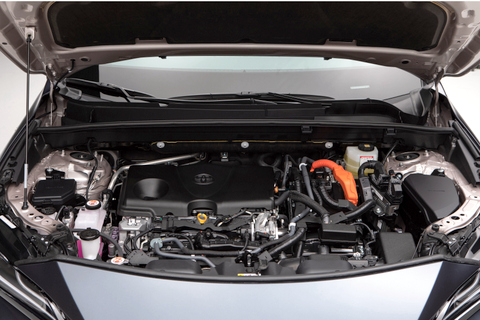
The Hybrid Power System generates 219 combined net horsepower from a 2.5-liter four-cylinder engine and a pair of electric motors (88 kilowatt [kW] and 40 kW. Standard electronic on-demand AWD and a continuously variable automatic transmission complete the drivetrain. This is a familiar and effective system, which moves the 3,919-pound, five-passenger Venza down the road with good EPA miles-per-gallon numbers—40 city/37 highway/39 combined. The EPA Green numbers are 7 for Smog and 8 for Greenhouse Gas. I averaged 34.0 mpg during my limited test.
Hybrid vehicles are efficient while requiring no action from the driver. There is no plug to charge the battery—it gets its electricity from regenerative braking every time you press the brake pedal. This means you just get in and go; however, you can improve your mileage by driving smoothly and gently and avoiding excessive speed. The vehicle emits 227 grams of CO2 per mile, which is about half of what a gas-only midsize car with this size engine would put out.
The Space
The Venza is roomy. None of its maximum of five occupants should feel cramped, and there’s plenty of headroom. Cargo volume is 28.7 cubic feet (cf) with the rear seats up, expanding to 54.9 cf with them folded. That’s plenty for most purposes.
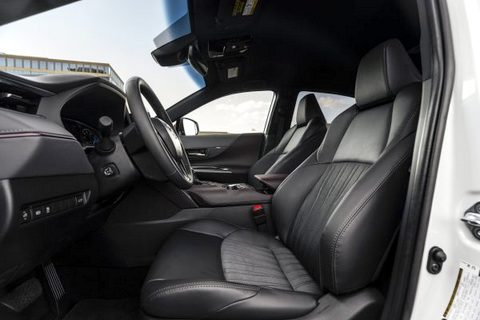
While many of Toyota’s vehicles are built in U.S. factories, the Venza is assembled in Aichi, Japan. Today’s vehicles are made up of thousands of parts from suppliers all over the world, so that information may not be particularly meaningful, but it does impact shipping charges (see below).
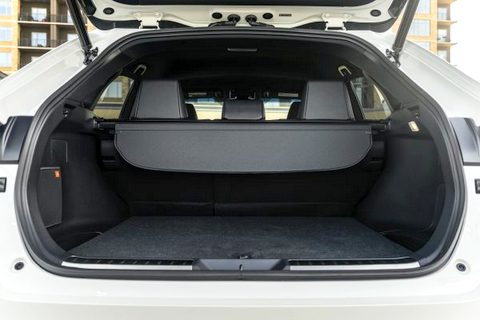
There are three trim levels, which use the standard Toyota nomenclature—LE, XLE, and Limited. As usual, you get more as you ascend the levels. My tester was a Limited, so it had everything on the menu, plus an optional Star Gaze Fixed Panoramic Roof ($1,400). This is likely more entertaining for passengers than the driver. The XLE and Limited share many upgrades from the LE, but most of the good stuff is included on all levels.
The Limited enhances some aspects, such as seats, and includes some unique features. It provides additional safety by giving you a better view of your surroundings with a digital rearview mirror, an integrated backup camera (with dynamic gridlines and a washer), and the Bird’s Eye View Camera with Perimeter Scan. Add in dual-zone climate control, heated and ventilated SofTex-trimmed seats (artificial leather). And you get illuminated door sills up front. See Toyota’s website for details.
The Looks
My Limited tester wore evocatively named Coastal Gray Metallic paint over 19-inch Multi-Spoke Super Chrome rims so, although the proportions were 2021 crossover, there was a little extra curb appeal. The exterior styling is a clean iteration of Toyota’s recent stretched taffy, fierce face design, with pointed rear side windows and taillamps that protrude like clipped fins in the rear. A deep spoiler projects over the rear window to aid aerodynamics. It does not have the upright lines or chunky wheel wells of an off-road truck-based SUV.
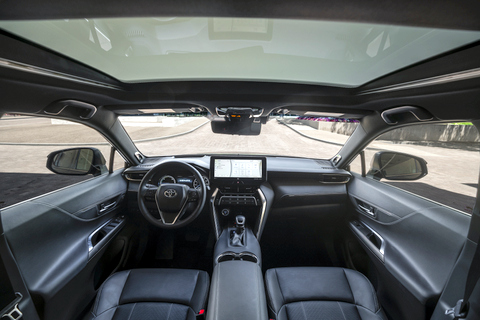
Inside, you’ll find a lot of Prius and Camry influences, with flowing panels and elegant matte finishes. The start button sits in plain sight on the center dash console. The center stack features long metallic parentheses around the controls with an information pod sitting above filled with useful data. The home screen displays audio, phone, map, and hybrid system data and graphs. Tap one to get the full screen for each.
The instrument panel is more rounded, visible through the leather-wrapped steering wheel, and features crisp, traditional needle gauges. The left gauge offers CHG (charge), ECO, and PWR (power) sections of the dial, so you can see how efficiently you’re driving at any time. The center panel displays the by now common info, from fuel economy to audio settings to vehicle configurations.
The Cost
Pricing starts at $32,470 for the LE, $36,000 for the XLE, and $39,800 for the Limited. Add $1,175 for delivery (it’s coming from Japan, remember) to each price. My tester came to $43,100.
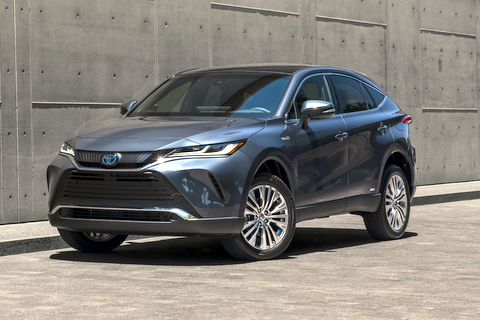
The new Venza is a pleasant, attractive, highly functional vehicle that should find some buyers in the crowded midsize SUV segment (check out below if you have any doubt of that). As a Toyota, it really doesn’t have a downside, and my short test turned up no issues. It didn’t stir up any passions, either, but that’s likely not its job. As a nearly-40-mpg hybrid, it’s a good car for today if a plug-in vehicle won’t work for you. However, I recommend leasing, so your next car can be fully electric. By then, even Toyota should have something to offer you.
Story by Steve Schaefer. Photos by Toyota.
Make sure to opt-in to the Clean Fleet Report newsletter (top right of page) to be notified of all new stories and vehicle reviews.
Related Stories You Might Enjoy—Midsize Crossover Craziness
Road Test: 2020 Kia Telluride
Road Test: 2021 Kia Sorento Hybrid
Road Test: 2020 Toyota Highlander Hybrid
Road Test: 2019 Subaru Ascent
Road Test: 2021 Volkswagen Atlas
Road Test: 2017 Nissan Pathfinder
Road Test: 2020 Ford Explorer Hybrid
Road Test: 2019 Mazda CX-9
Road Test: 2020 Hyundai Santa Fe
Road Test: 2019 Jeep Grand Cherokee
Road Test: 2019 Chevrolet Blazer
Road Test: 2019 Buick Enclave
Road Test: 2019 Ford Edge
Disclosure:
Clean Fleet Report is loaned free test vehicles from automakers to evaluate, typically for a week at a time. Our road tests are based on this one-week drive of a new vehicle. Because of this we don’t address issues such as long-term reliability or total cost of ownership. In addition, we are often invited to manufacturer events highlighting new vehicles or technology. As part of these events we may be offered free transportation, lodging or meals. We do our best to present our unvarnished evaluations of vehicles and news irrespective of these inducements.
Our focus is on vehicles that offer the best fuel economy in their class, which leads us to emphasize electric cars, plug-in hybrids, hybrids and diesels. We also feature those efficient gas-powered vehicles that are among the top mpg vehicles in their class. In addition, we aim to offer reviews and news on advanced technology and the alternative fuel vehicle market. We welcome any feedback from vehicle owners and are dedicated to providing a forum for alternative viewpoints. Please let us know your views at publisher@cleanfleetreport.com.


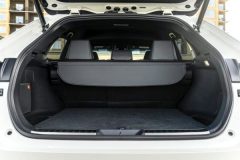
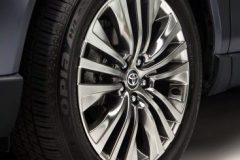
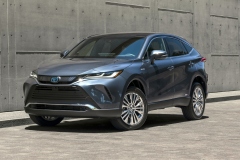
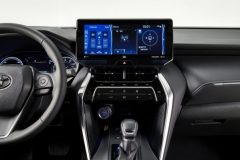

2 thoughts on “Road Test: 2021 Toyota Venza Hybrid”